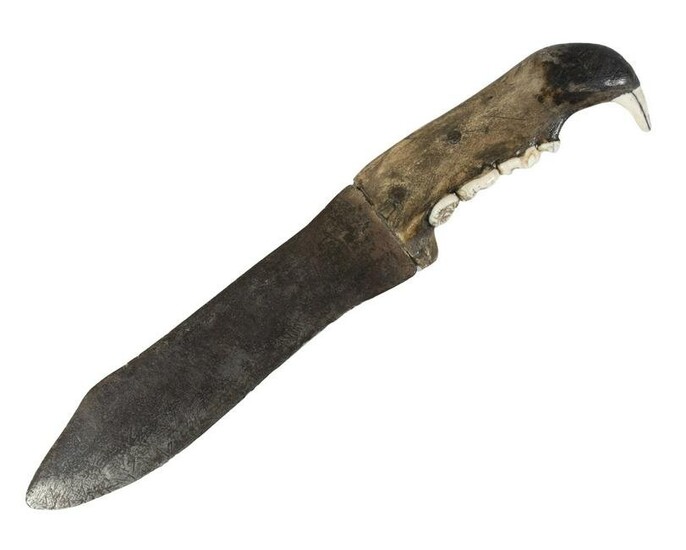RARE BLACKFOOT DAGGER WITH BEAR JAW HANDLE, CIRCA 1890
19th c. single edge steel blade, two part handle with two rivets. 7 3/4" blade, 12 1/2" overall.Per Wendell Grangaard of Guns of History, Sioux Falls, SD: "During my examination of this Blackfoot knife, I found the name Bull written in Togia on the right side of the blade, along with this message: 'Fast Cloud - son - Bull'. On the left handle I found 'Bull' three times, with the togia mark of Blackfoot. On the left side of the blade I found 'Bull' written twice, with the mark 'Ghost Dance'. On the right handle, the name 'Bull' is written twice with the message 'son-Fast Cloud'. The bottom of the handle contains a special togia message: 'rode together - Bull - Plenty Cups - married - departed'.Bull was born in 1824 to Blackfoot parents. He joined John Grass's band of Sihasapa when he came of age. He married Plenty Cups and they had one son, Fast Cloud, who was born in 1841. Plenty Cups left her family at some time and married another man, Omaha. Bull then moved in with his son Fast Cloud and his wife, 'Her White Baby'. I believe this knife was handmade by Bull for the Ghost Dance movement. Kicking Bear, a Minneconjou, brought the Ghost Dance to the Sioux at the Pine Ridge Reservation, and then brought the ways of the dance to Sitting Bull. Sitting Bull gave Kicking Bear permission to teach it on the Standing Rock Reservation. The Ghost Dance was originally a peaceful dance, but because Sioux tended to make many things warlike, the Dance became so as well. According to historical stories, Kicking Bear was told by Wovoka, the creator of the Dance, that each person who participated in the Dance must wear one thing that was personally made by them, such as the Ghost Dance shirt. The participants were not allowed to wear or carry anything made by the wasicu (white man). The Sioux also felt it was important to be armed at all times, so each dancer tended to make a knife or a hatchet to carry during the dance. Bull and his son lived on the Grand River in the John Grass Community on Standing Rock."From Blackpipe to the collection of Tom Hampton. Provenance: Folder of documents with letter from Gragaard describing Togia inscriptions.
[ translate ]Estimate
Time, Location
Auction House
19th c. single edge steel blade, two part handle with two rivets. 7 3/4" blade, 12 1/2" overall.Per Wendell Grangaard of Guns of History, Sioux Falls, SD: "During my examination of this Blackfoot knife, I found the name Bull written in Togia on the right side of the blade, along with this message: 'Fast Cloud - son - Bull'. On the left handle I found 'Bull' three times, with the togia mark of Blackfoot. On the left side of the blade I found 'Bull' written twice, with the mark 'Ghost Dance'. On the right handle, the name 'Bull' is written twice with the message 'son-Fast Cloud'. The bottom of the handle contains a special togia message: 'rode together - Bull - Plenty Cups - married - departed'.Bull was born in 1824 to Blackfoot parents. He joined John Grass's band of Sihasapa when he came of age. He married Plenty Cups and they had one son, Fast Cloud, who was born in 1841. Plenty Cups left her family at some time and married another man, Omaha. Bull then moved in with his son Fast Cloud and his wife, 'Her White Baby'. I believe this knife was handmade by Bull for the Ghost Dance movement. Kicking Bear, a Minneconjou, brought the Ghost Dance to the Sioux at the Pine Ridge Reservation, and then brought the ways of the dance to Sitting Bull. Sitting Bull gave Kicking Bear permission to teach it on the Standing Rock Reservation. The Ghost Dance was originally a peaceful dance, but because Sioux tended to make many things warlike, the Dance became so as well. According to historical stories, Kicking Bear was told by Wovoka, the creator of the Dance, that each person who participated in the Dance must wear one thing that was personally made by them, such as the Ghost Dance shirt. The participants were not allowed to wear or carry anything made by the wasicu (white man). The Sioux also felt it was important to be armed at all times, so each dancer tended to make a knife or a hatchet to carry during the dance. Bull and his son lived on the Grand River in the John Grass Community on Standing Rock."From Blackpipe to the collection of Tom Hampton. Provenance: Folder of documents with letter from Gragaard describing Togia inscriptions.
[ translate ]


